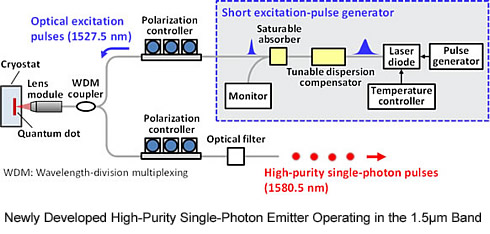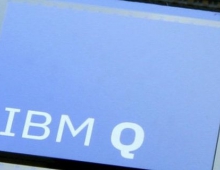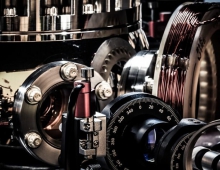
Japanese Researchers Succeed in Quantum Key Distribution at World-Record Distance of 120 km
Driving toward the practical implementation of the ultimate in secure communications for metropolitan areas, the Institute for Nano Quantum Information Electronics, the University of Tokyo, in collaboration with Fujitsu Laboratories and NEC Corp. have achieved quantum key distribution at a world-record distance of 120 km using a system with a single-photon emitter. These results were generated using an optical fiber quantum key distribution (QKD) system that was newly developed by the three parties. A quantum key distribution (QKD) system can be used for secret communications, where a sender and receiver can safely share a private key by taking advantage of quantum mechanics.
The system is comprised of a high-purity quantum dot single-photon emitter operating in the 1.5 micrometer band, which reduces the occurrence of simultaneous multi-photon emissions, one of the major limiting factors for long-distance QKD, to one in a million. Another component is an optical-fiber-based QKD system optimized for use with single-photon emitters by employing superconducting single-photon detectors with ultra-low-noise characteristics. This single-photon QKD system, which simplifies system operations and management, has now achieved a transmission distance of 120 km.
It is expected that this system will bring significant momentum to achieving secure communications that are impossible to eavesdrop on and that cover major metropolitan areas.

Details
QKD is a technology that uses individual photons (i.e. particles of light) to convey information, enabling two parties to share a cryptographic key. If an eavesdropper tries to steal the key information on the transmission line, it results in changes to the states of the photons in accordance with the basic principles of quantum mechanics. Since any eavesdropping can therefore be detected, it enables completely secure communications.
In QKD, a device known as a single-photon emitter is required to generate photons one at a time. Until now, however, most QKD systems have used attenuated laser light as a pseudo single-photon emitter. But with pseudo single-photon emitters, there is a high probability that they will emit two or more photons in a single pulse, meaning that the risk that an eavesdropper will steal key information from a portion of the multiple photons cannot be eliminated. To address this problem, one widely used method to detect eavesdropping is to artificially mix optical pulses with different intensities (decoy states). With this method, however, both the transmitter setup and the key extraction process become complicated, and the other problem occurs that excessive attention is required in managing and operating the system in order to maintain security.

If the pseudo single-photon emitter can be replaced with a true one, the setup of a QKD system can be greatly simplified, so that the high level of security guaranteed by the laws of quantum mechanics can be attained. In conventional QKD systems with quantum dot single-photon emitters, however, there are two problems. One is the high probability of generating unwanted multiple photons from a single-photon emitter. The other is high background noise when detecting single photons by using semiconductor detectors. Because of the impact of these two problems, even when using the 1.5 micrometer band, which is advantageous for long distance transmissions, the maximum distance for secure key distribution was limited to 50 km. Therefore, to create a practical QKD system using a single-photon emitter, performance improvements were needed, both in the light source and on the system side.

The newly developed an optical fiber QKD system comprised of two key components. One is a high-purity quantum dot single-photon emitter operating in the 1.5 micrometer band, which reduces the occurrence of simultaneous multi-photon emissions, one of the major limiting factors for long-distance QKD, to one in a million.
The other is an optical-fiber-based QKD system optimized for use with single-photon emitters by employing superconducting single-photon detectors with ultra-low-noise characteristics. Using this system with a single-photon emitter, the partners have verified secure key distribution at a world-record distance of 120 km, twice the previous longest distance.
Based on these results, the researchers will work on making the single-photon QKD system more compact and faster, with the aim of rolling out from 2020 highly secure communications for major urban centers.





















